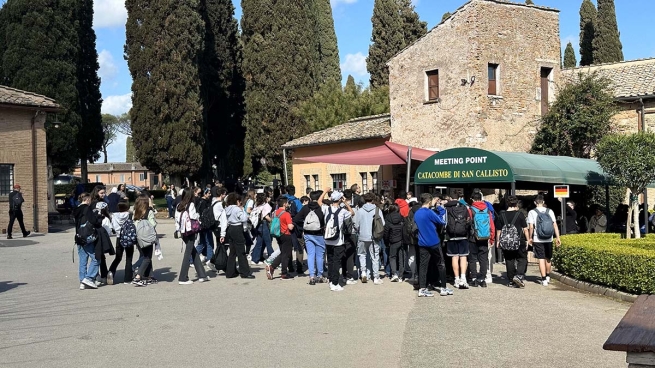The Catacombs of San Callisto are among the largest and most important in Rome. They arose in the middle of the second century and are part of a cemetery complex that occupies an area of 15 hectares of land, with a network of tunnels almost 20 kilometres long, on several floors, and reach a depth of more than 20 metres. Dozens of martyrs, 16 popes and many Christians were buried in them.
Pius XI, who had met Don Bosco and sensed the good that the Salesian Congregation could do by welcoming pilgrims and visitors to this important place for the Church in the early centuries, decided to entrust the custody of the Catacombs of San Callisto to the Salesians of Don Bosco in 1930.
Since then, many Salesians have cared for and continue to care for the reception in the Catacombs, and some of them rest in a small cemetery at the entrance of the district. Today there are 16 Salesians, literally from all over the world, who make the Catacombs known, in every language, to visitors and pilgrims.
What is proposed is not so much a touristic and archaeological visit, but a real spiritual journey experienced through the symbols, tombs, testimonies and history of this place.
Here, in fact, in a journey that lasts an average of 45 minutes, the stories of the martyred popes who rest in the Crypt of the Popes are told, the most sacred and important place of these catacombs, called "the little Vatican" because 9 popes and, probably, 8 dignitaries of the Church of the third century were buried there. Not only that, passing through the so-called "sopratterra" there are two basilicas with three apses, called "Tricore". In the eastern one, Pope Saint Zephyrinus and the young martyr of the Eucharist, Saint Tarcisius, were probably buried.
Also of great importance is the Crypt of Saint Cecilia, patron saint of music. Of noble Roman family, she was martyred in the third century. Buried where her statue now stands, she was venerated here for at least five centuries. In the year 821 her relics were transported to Trastevere in the basilica dedicated to her.
Inside the Catacombs of San Callisto, you can also admire ancient frescoes dating from the early third century, which symbolically represent the sacraments of Baptism and the Eucharist.
During the visit, each group can stop either in a crypt, or in a surface chapel, for a brief moment of prayer or for the celebration of Mass. Even just praying, with the litanies of the saints and martyrs of San Callisto, evokes a world of sensations and faith.
To facilitate the visit, the Catacombs also have a large parking lot, a refreshment point and large open spaces for play, lunch and to encourage moments of conviviality and encounter.
Added value is the presence, in the same area, of the Salesian Postnovitiate, where you can find hospitality for the night, a hot meal and meeting rooms.
For more information on the Catacombs, to learn more about their history and to book a visit, you can visit the website.
https://www.infoans.org/en/component/k2/item/20924#sigProId6a2a53793b



